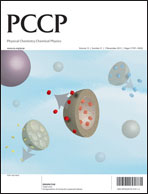Probing the interface of doped isotopically mixed helium droplets by the directional anisotropy of interatomic Coulombic decay
Abstract
Interatomic Coulombic decay (ICD) represents an efficient electronic relaxation mechanism of an ionized or an excited system embedded in an environment. The type of this environment and its size have a great impact on the ICD performance. It is stressed that ICD is sensitive to the arrangement of neighboring atoms when the initially created vacancy has a polarization direction. This is demonstrated in the present paper for the case of a 3p-ionized Ca surrounded by He atoms. Useful explicit expressions are derived for the ICD widths which show that the neighbors located along the polarization direction of the ionized orbital have the largest contribution to the ICD rate. By comparison with ab initio results for small clusters, we also show that in a helium environment, the pairwise approximation represents a reliable approach for computing ICD widths. Using this approximation and the density distribution of the helium atoms obtained within density functional theory, we explore ICD in large isotopically mixed helium droplets doped with Ca. A special emphasis is given to the difference between the ICD widths for the Ca3p orbitals directed perpendicular and parallel to the droplet surface. Depending on the size and isotopic composition of the droplet, Ca resides in the interfacial layer between the 4He core and the 3He outer shell. Hence, ICD studies in these droplets may provide valuable information on the properties of this interface.


 Please wait while we load your content...
Please wait while we load your content...